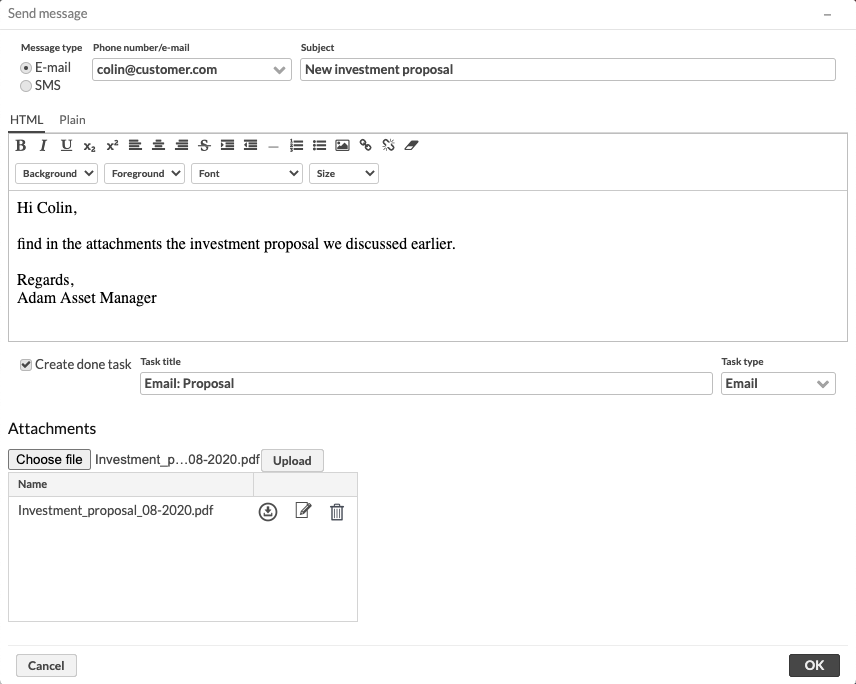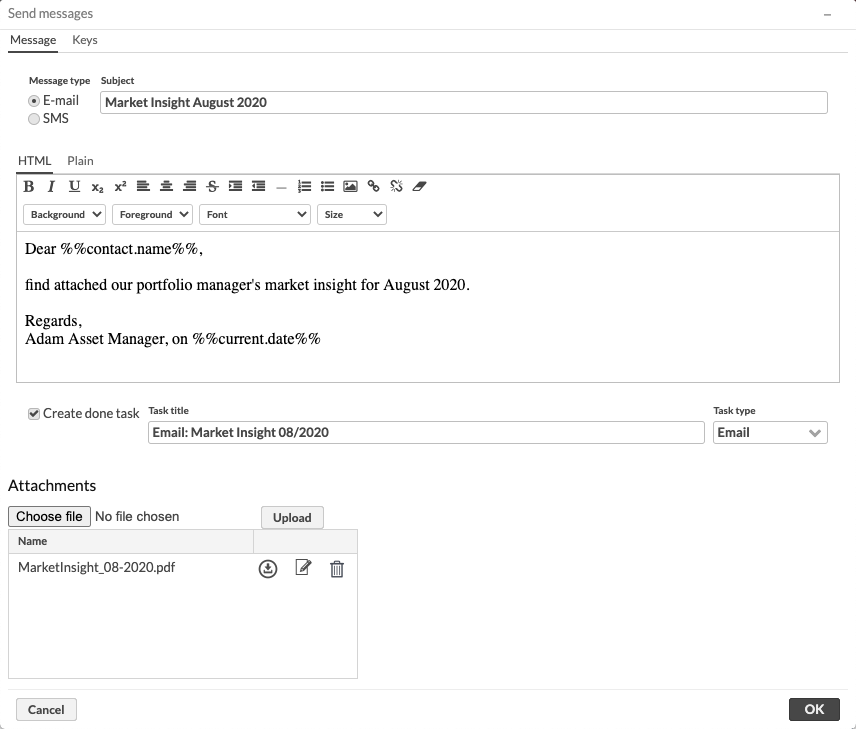[Extension] Send messages
Overview to sending messages
Messaging package available in FA AppStore allows you to send emails and SMS messages to your customer directly from FA, and receive your customers' replies to your messages. All sent and received messages are stored within your other customer-related information, providing you with a record of all customer communication in one place. You can send messages to your clients one-by-one, or you can mass-send messages to multiple clients at once based on a search. In addition, you can send messages to your clients based on transactions or trade orders created for them.
Send message to a single recipient
You can send a message to a single contact through right-clicking your contact on the Overview or through opening your contact on Customers view. You can freely define your message, and send it to an email address or phone number stored under your contact's address information. Steps to send a message are simple: define your message in the available window, and after you are done, a single message is sent to your contact.

Send message window contains the following selections:
- Message type
Email or SMS.
- Phone number / e-mail
The email address or phone number you want to send your message to. The available options are automatically fetched from the selected contact's address information.
- Subject
Message subject (available for emails only).
- Message content
Message content either in HTML (available for emails only) or plain text. The built-in editor helps you to add HTML markup to the emails you send.
- Create done task
If you want to track what kind of emails have been sent and to which clients, you can choose to automatically record a done task from sent emails, linked to the email recipient. When enabled, define a title for your task and select the task type - if the title is left empty, the message subject or fixed text "SMS" is used as the title of the created task.
- Attachments
Upload attachments to the message (available for emails only).
You can configure the "from address" for sent emails through process configurations.
Send messages to multiple recipients
You can also send messages simultaneously to multiple contacts based on a contact search on Contacts view or Customers view, or based on transactions or trade orders created for your contacts. When mass-sending messages, a separate message is sent to all the contacts shown in your search result - you can easily fetch contacts matching certain criteria, and send the same message to all of them at once. Steps to mass-send messages are simple: define your message in the available window, and after you are done, an individual message is sent to each contact in your search result.
When mass-sending messaged, you can define your email message subject and content with dynamic text, filling in data from the contact the email is sent to. This allows you to personalize your emails when mass-sending them - for example, you can include the email recipient's name within the email content. In addition, when mass-sending messages, email addresses and phone numbers are automatically fetched from the contacts you are sending the messages to: the email address or phone number is retrieved from the first address with this information available. If no email address or phone number is found, the message cannot be sent.

Send message window contains the following selections:
- Message type
Email or SMS,
- Subject
Message subject (available for emails only).
- Message content
Message content either in HTML (available for emails only) or plain text. The built-in editor helps you to add HTML markup to the emails you send. In addition, you can define your email message subject and content with dynamic text, filling in data from the contact the email is sent to. You can do this through embedding dynamic keys into your message subject or content - the tab Keys provides you with a list of keywords you can use in the message by adding two percent signs on both sides of the keyword. For example, %%contact.name%% within you message is replaced by the contact's name in FA.
- Create done task
if you want to track what kind of emails have been sent and to which clients, you can choose to automatically record a separate done task from each sent email, linked to each email recipient. When enabled, define a title for your task and select the task type - if the title is left empty, the message subject or fixed text "SMS" is used as the title of the created task.
- Attachments
Upload attachments to the message (available for emails only).
After sending the messages, you will get a notification letting you know how many messages were sent and if there were any failed ones or if any of the contacts had missing information.
You can configure the "from address" for sent emails through process configurations.
Receive e-mails and SMS
You can automatically record inbound emails and SMS messages. Messages received by a specific email address or phone number can be recorded as task: if a matching email address or phone number can be found stored on a contact in the system, the inbound message task is linked to the matching contact. Email attachments are also automatically saved into the matching contact's documents.

Received emails and SMS are shown in the task lists in the Tasks view. Messages are shown either as "open" tasks or "completed" tasks, depending on whether the email originates from a client or whether it is forwarded within your organization (you can configure the list of domains or email addresses belonging to your organization). If an email originates from within your organization, it is automatically saved as a "completed" task, otherwise the email is shown as an "open" task. SMS messages are always shown as "open" tasks.
When you open a "Read message" task from a task list showing open tasks, you can read the message, check the attachments, and then choose to disregard it (Cancel), reply to it through sending a message (Reply) or save it under the corresponding contact without replying (OK). The corresponding contact is automatically determined based on the e-mail address or phone number the message originates from - you can see this information at the top of the open message.